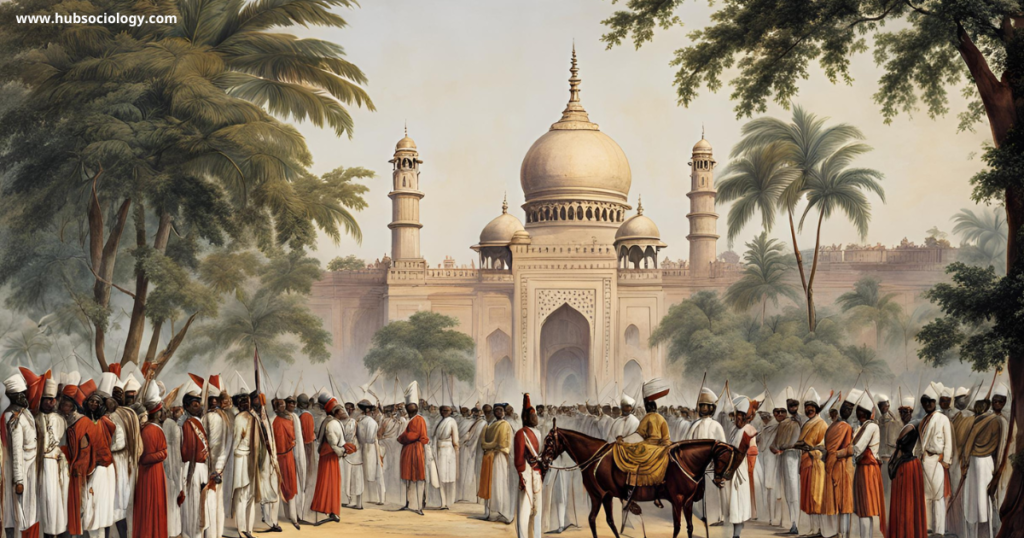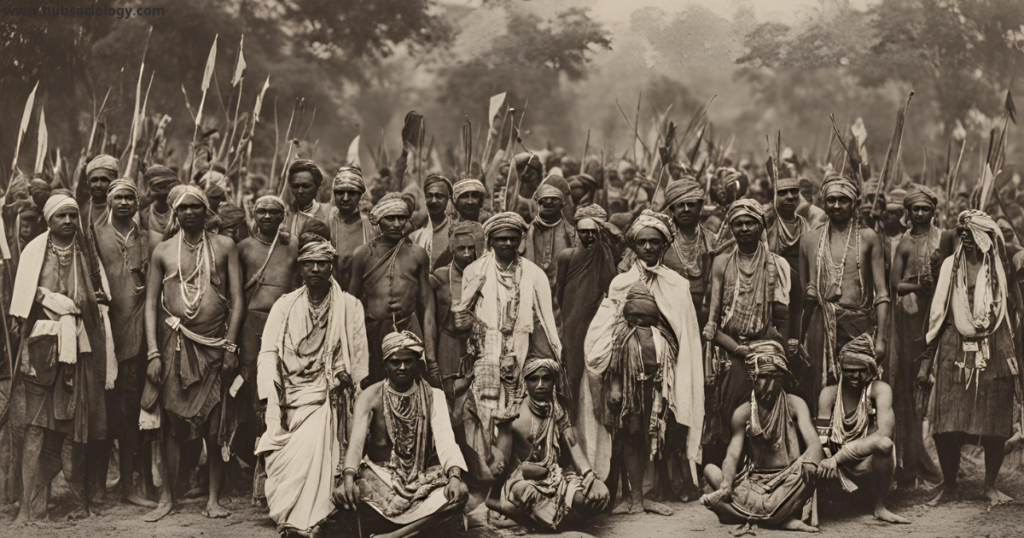India, with its rich tapestry of cultures, religions, and traditions, has historically been a land of diverse social practices and beliefs. However, many of these practices were deeply entrenched in hierarchical structures, caste systems, and gender inequalities. The 19th and early 20th centuries witnessed the emergence of socio-religious reform movements that sought to address these issues and bring about significant social change. These movements, rooted in both religious and social contexts, played a pivotal role in reshaping Indian society.
From a sociological perspective, these reforms can be understood as responses to the colonial encounter, the influence of Western ideas, and the internal critique of traditional practices. This article explores the major socio-religious reform movements in India and their impact on social change, focusing on their sociological implications.

Historical Context: Colonialism and the Need for Reform
The advent of British colonial rule in India brought with it not only political and economic changes but also a confrontation between traditional Indian society and modern Western ideas. The colonial administration, while exploiting India economically, also introduced Western education, legal systems, and ideologies such as liberalism, rationalism, and individualism. These ideas exposed the contradictions and injustices within Indian society, particularly the caste system, gender discrimination, and religious orthodoxy.
Simultaneously, the Indian elite, who were exposed to Western education, began to critically examine their own social and religious practices. This led to a dual process of reform: on one hand, there was an attempt to reinterpret and revive traditional Indian values, and on the other, there was an effort to adopt progressive ideas from the West. The socio-religious reform movements that emerged during this period were thus a response to both internal and external stimuli.
Major Socio-Religious Reform Movements
- Brahmo Samaj (1828)
Founded by Raja Ram Mohan Roy, the Brahmo Samaj was one of the earliest and most influential reform movements in India. Roy, often referred to as the “Father of Modern India,” sought to reform Hinduism by rejecting idol worship, caste distinctions, and superstitious practices. He advocated for monotheism, rationalism, and the principles of equality and social justice. The Brahmo Samaj emphasized the importance of education, particularly for women, and played a significant role in the abolition of practices like Sati (the immolation of widows on their husband’s funeral pyres).From a sociological perspective, the Brahmo Samaj can be seen as an attempt to reconcile traditional Indian values with modern Western ideas. It challenged the hegemony of orthodox Hinduism and laid the foundation for a more inclusive and egalitarian society. - Arya Samaj (1875)
Founded by Swami Dayananda Saraswati, the Arya Samaj was a reform movement that sought to return to the “pure” Vedic traditions of Hinduism. Dayananda rejected the later accretions of Hinduism, such as idol worship, casteism, and ritualism, and emphasized the authority of the Vedas. The Arya Samaj advocated for social equality, education for all, and the upliftment of women. It also played a significant role in the Shuddhi movement, which aimed to reconvert individuals who had adopted other religions.Sociologically, the Arya Samaj represented a nativist response to colonialism and Christian missionary activities. It sought to assert the superiority of Indian culture and religion while simultaneously reforming its social practices. The movement’s emphasis on education and social equality had a lasting impact on Indian society. - Ramakrishna Mission (1897)
Founded by Swami Vivekananda, the Ramakrishna Mission was inspired by the teachings of Sri Ramakrishna Paramahamsa. Vivekananda emphasized the universality of religions and the importance of social service. The mission focused on education, healthcare, and the upliftment of the poor and marginalized. Vivekananda’s famous speech at the World’s Parliament of Religions in Chicago in 1893 brought international attention to Indian spirituality and philosophy.From a sociological perspective, the Ramakrishna Mission can be seen as a bridge between tradition and modernity. It combined spiritual teachings with practical social work, emphasizing the importance of serving humanity as a form of worship. The mission’s focus on social service and education contributed to the development of a more compassionate and inclusive society. - Prarthana Samaj (1867)
Founded by Dr. Atmaram Pandurang, the Prarthana Samaj was influenced by the Brahmo Samaj and sought to reform Hinduism in Maharashtra. The movement emphasized monotheism, social reform, and the importance of education. It played a significant role in the abolition of caste distinctions, the promotion of widow remarriage, and the upliftment of women. The Prarthana Samaj also worked towards the eradication of social evils like child marriage and the dowry system.Sociologically, the Prarthana Samaj represented a regional response to the broader reform movements in India. It highlighted the importance of local contexts in shaping social reform and demonstrated the interconnectedness of religious and social issues. - Aligarh Movement (1875)
Led by Sir Syed Ahmed Khan, the Aligarh Movement was a reform movement within the Muslim community. Sir Syed emphasized the importance of modern education and scientific thinking for the progress of the Muslim community. He founded the Muhammadan Anglo-Oriental College (later Aligarh Muslim University) to provide Western-style education to Muslims. The movement sought to reconcile Islamic teachings with modern ideas and played a crucial role in the intellectual and social upliftment of the Muslim community.From a sociological perspective, the Aligarh Movement can be seen as a response to the marginalization of Muslims in colonial India. It sought to empower the community through education and social reform, challenging both traditional orthodoxy and colonial stereotypes. - Sikh Reform Movements
The late 19th and early 20th centuries also saw the emergence of reform movements within the Sikh community, such as the Singh Sabha Movement. These movements sought to revive Sikhism’s original teachings, promote education, and combat social evils like casteism and gender discrimination. The Akali Movement, which emerged in the early 20th century, focused on reforming Sikh religious institutions and played a significant role in the struggle for Indian independence.Sociologically, these movements represented an attempt to assert Sikh identity and address social issues within the community. They contributed to the broader process of social change in India by challenging traditional hierarchies and promoting equality.

Impact on Social Change
The socio-religious reform movements had a profound impact on Indian society, contributing to significant social change in several ways:
- Challenging Caste Hierarchies
One of the most significant contributions of these movements was their challenge to the caste system. By advocating for social equality and rejecting caste distinctions, the reform movements laid the groundwork for a more egalitarian society. The emphasis on education and social upliftment also helped to empower marginalized communities. - Empowerment of Women
The reform movements played a crucial role in the empowerment of women. They advocated for women’s education, the abolition of practices like Sati and child marriage, and the promotion of widow remarriage. These efforts contributed to the gradual improvement of women’s status in Indian society. - Promotion of Education
Education was a central focus of many reform movements. By establishing schools, colleges, and other educational institutions, these movements helped to spread modern education and scientific thinking. This had a transformative impact on Indian society, leading to greater social mobility and intellectual development. - Religious and Social Pluralism
The reform movements emphasized the importance of religious tolerance and pluralism. By advocating for the universality of religions and the rejection of religious orthodoxy, they contributed to a more inclusive and harmonious society. - National Consciousness
Many of these reform movements also played a role in the development of national consciousness. By challenging colonial stereotypes and asserting Indian cultural and spiritual values, they contributed to the broader struggle for Indian independence.

Conclusion
The socio-religious reform movements in India were a response to the challenges posed by colonialism, traditional orthodoxy, and social inequalities. From a sociological perspective, these movements can be seen as attempts to reconcile tradition with modernity, challenge hierarchical structures, and promote social justice. Their impact on Indian society was profound, leading to significant social change in areas such as caste, gender, education, and religious pluralism. While the process of social reform is ongoing, the legacy of these movements continues to shape contemporary Indian society. They remind us of the importance of critical self-reflection, social activism, and the pursuit of justice in the quest for a more equitable and inclusive world.
Topic Related Questions
5 Marks Questions (Short Answer)
- Define socio-religious reform movements. Name any two prominent reform movements in 19th-century India.
- What was the role of Raja Ram Mohan Roy in the Brahmo Samaj?
- How did the Arya Samaj contribute to the upliftment of women in Indian society?
- Explain the significance of the Aligarh Movement in the context of Muslim social reform.
- What were the main objectives of the Prarthana Samaj?
- How did Swami Vivekananda’s Ramakrishna Mission promote social service?
- What was the Shuddhi Movement, and how did it impact Indian society?
- Discuss the role of education in the socio-religious reform movements of India.
- How did the Singh Sabha Movement contribute to Sikh religious and social reform?
- What were the key social evils targeted by the socio-religious reform movements in India?
10 Marks Questions (Detailed Answer)
- Discuss the role of the Brahmo Samaj in challenging caste hierarchies and promoting social equality in 19th-century India.
- Analyze the impact of the Arya Samaj on Indian society, with a focus on its efforts to revive Vedic traditions and promote social reform.
- Examine the contributions of Swami Vivekananda and the Ramakrishna Mission to social change in India.
- How did the socio-religious reform movements address the issue of gender inequality in colonial India?
- Discuss the role of Sir Syed Ahmed Khan and the Aligarh Movement in the modernization of the Muslim community in India.
- Compare and contrast the Brahmo Samaj and the Prarthana Samaj in terms of their objectives and contributions to social reform.
- Evaluate the role of socio-religious reform movements in promoting education and scientific thinking in India.
- How did the socio-religious reform movements contribute to the development of a national consciousness in India?
- Discuss the impact of the Singh Sabha Movement on Sikh identity and social reform.
- Explain how the socio-religious reform movements acted as a bridge between tradition and modernity in colonial India.
15 Marks Questions (Essay-Type Answer)
- Critically analyze the role of socio-religious reform movements in bringing about social change in 19th and early 20th-century India.
- Discuss the impact of socio-religious reform movements on caste, gender, and education in colonial India.
- How did the socio-religious reform movements challenge traditional orthodoxy and promote rationalism and social justice in India?
- Examine the role of socio-religious reform movements in shaping the cultural and social fabric of modern India.
- Discuss the contributions of Raja Ram Mohan Roy, Swami Dayananda Saraswati, and Swami Vivekananda to the socio-religious reform movements in India.
- Evaluate the role of socio-religious reform movements in fostering religious pluralism and social harmony in India.
- How did the socio-religious reform movements respond to the challenges posed by colonialism and Western ideas?
- Discuss the role of socio-religious reform movements in empowering marginalized communities and promoting social equality in India.
- Analyze the impact of the Aligarh Movement and the Singh Sabha Movement on their respective communities and Indian society as a whole.
- “The socio-religious reform movements were not just religious in nature but also deeply social and political.” Discuss this statement in the context of colonial India.

2 thoughts on “Socio-Religious Reform Movements and Their Influence on Social Change in India”